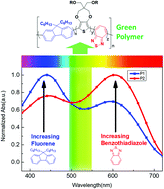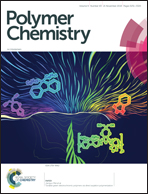Tunable green electrochromic polymers via direct arylation polymerization†
Abstract
A method to tune the hues of neutral green conjugated electrochromic polymers (NG-ECP) via direct C–H arylation polymerization (DArP) was developed. We used 4,7-dibromo-2,1,3-benzothidiazole and 2,7-dibromofluorene to randomly copolymerize with ProDOT via DArP and successfully obtained a series of green polymers. On varying the ratio of 4,7-dibromo-2,1,3-benzothidiazole and 2,7-dibromofluorene, we can readily adjust the relative intensity of two absorption bands in the visible-light wavelength region, which leads to four green polymers with different hues being obtained. Specifically, increasing the ratio of 4,7-dibromo-2,1,3-benzothidiazole leads to the enhancement of the polymer absorption intensity in the long wavelength (∼550–700 nm) region, while increasing the ratio of 2,7-dibromofluorene will lead to the increase of the polymer absorption intensity in the short wavelength (∼400–500 nm) region. Via the random direct arylation polymerization of multi-component monomers in various ratios, we can precisely control the absorption spectra of neutral green conjugated electrochromic polymers (NG-ECPs) in the visible-light wavelength region. The electrochemical and optical properties, spectroelectrochemical behaviors, and electrochromic performance of these NG-ECPs were characterized and they showed great potential for electrochromic devices such as smart windows and transmissive displays.



 Please wait while we load your content...
Please wait while we load your content...